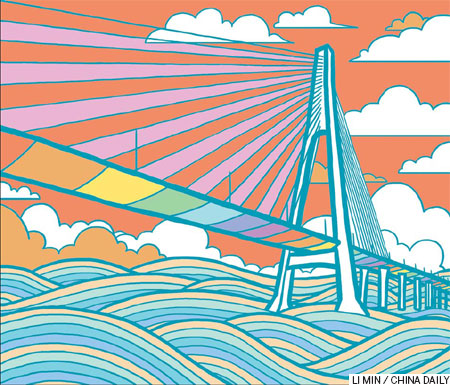The bridges that hold nations together
Updated: 2011-12-30 08:51
By Lei Junqing (China Daily)
|
||||||||

To promote balanced economic development and improve a country's overall national strength, many countries have begun to build cross-sea bridges. China is no exception.
This year the number of large cross-sea bridges has surpassed 30 worldwide. In 1973 the Turkish Bosphorus Bridge, dubbed the Eurasian Bridge, was completed. It was the first cross-sea bridge to cross the Bosphorus Strait and connect Asia with Europe. The Bahrain-Saudi Arabia Bridge, spanning 25 kilometers, was completed in 1986, and it was the world's longest cross-sea bridge at the time. In 1988 Seto Bridge in Japan, connecting Honshu Island with several islands, opened.
After the founding of New China, the government accelerated the pace of bridge development. Since 2000 the number of cross-sea bridges built or being built has surpassed 30.
Xiamen Bridge in Fujian province, completed in 1991, was the country's first cross-sea bridge. Hangzhou Bay Bridge, completed in 2008, was the world's longest cross-sea bridge at that time. Crossing over the Hangzhou Bay, it integrates the whole Yangtze River Delta region, including Shanghai, Jiangsu and Zhejiang. Zhoushan Bridge in Zhejiang province was opened to traffic in 2009. Mires Bay (Dapeng Wan) cross-sea bridge in Taiwan was completed in 2011. This cable-stayed bridge has become a local landmark. Qingdao Bay Bridge in Shandong province opened in June.
Among the many structures being built are Quanzhou Bay Bridge in Fujian province, Zhejiang Xiangshan Port Bridge, Hong Kong-Zhuhai-Macao Bridge, and Taiwan Golden Gate Bridge.
China is a big maritime country. Its continental coastline is 18,000 kilometers long. With over 6,400 islands of varied sizes (of which 60 percent are located in the East China Sea, 30 percent in the South China Sea, and 10 percent in the Yellow sea and Bohai Sea), the country's marine land covers 3 million square kilometers, equivalent to the size of 20 Shandong provinces. China's island coastline is 14,000 kilometers long, so the total coastline is 32,000 kilometers long.
However, China's population is the same as that of 30 countries in Europe, plus the US and Japan combined. China's arable land area per person is only one-third of the world's average; China's mineral resources share per person is less than half of the world's average. However, China is rich in a variety of marine resources that have yet to be developed, such as biological resources, mineral resources, space resources, water resources, and coastal tourism resources. Therefore, the 21st century is the century of China's maritime development.
Today the world has entered a new era of economic integration. With the deepening of reform and opening-up, the coastal regions have witnessed rapid development, as demonstrated in the Yangtze River Delta, Pearl River Delta, Hong Kong-Zhuhai-Macao region, the Bohai economic rim and the west bank region of the Taiwan Straits. Nearly two years ago the central government decided to turn Hainan island (China's second largest after Taiwan) into "an international tourist island".
The government made new requirements for transport construction in coastal areas and islands to accelerate its development. Frequent exchanges across the Taiwan Straits raise the demand for developing cross-Straits traffic. The construction of a cross-Taiwan Straits bridge has been proposed.
Such sea bridges refer to those built across a strait or a gulf. The bridge span is long and the environment is often complex, so the technology used to build such bridges is very demanding. The shortest cross-sea bridge is at least a few kilometers, and some big bridges often stretch to tens of kilometers long. They are the embodiment of top bridge technology.
The construction of cross-sea bridges is of great significance to a country's political, economic, defense, and environmental sectors. It epitomizes top bridge technology, which represents a country's strength and bridge construction technology level. More countries have started planning for cross-sea bridges.
Bridge construction will play an important role in surrounding regions' economic development, and that of the whole country for that matter. First, the bridge can bring about high rates of logistics flow; second, the bridge can result in industrial infrastructure being upgraded and can enhance the radiating effects of urban areas; third, the bridge can promote tourism. In addition to providing convenient travel destinations, the bridge itself can become an important tourist attraction.
Cross-sea bridge construction has great strategic significance to a country's defense. The Bosphorus Bridge completed in 1973, which spans the Bosphorous Strait, with the Black Sea to the north and the Marmara Sea to the south, is the access to the outside for countries along the Black Sea. With high cliffs along both banks, the bridge is of great military significance.
In addition, the bridges also help in energy saving by reducing travel time. Cross-sea bridges also play a significant role in marine industries. They will contribute to the rational use of marine space and energy, while promoting the development and progress of the port industry.
From its enormous advantages on a country's political, economic, defense and environmental aspects, cross-sea bridge construction is a must for accelerating globalization.
The author is a professor at the Beijing Jiaotong University.











